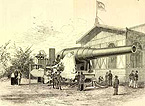Schrift: größer/kleiner
Inhaltsverzeichnis
Sie sind hier: WirRheinländer > english version > First World War (1914 - 1918) > Trench warfare
First World War (1914 - 1918)
Trench warfare or: the retreat of humanity in the face of technology
The generals of all the nations involved wanted to win tomorrow's war with the methods of yesterday. Their strategic thinking was still completely biased towards short, mobile warfare in the style of 1870/71. Long before the outbreak of the First World war, wide-ranging operative plans lay in the desk-drawers of the military in both France and Germany (Plan XVIII or the Schlieffen-Plan).

However, they completely underestimated the further development of weapons technology. That included the devastating effect of the machinegun, which had been invented back in 1885 by Hieram Maxim. Just as on the French side at least, they did not believe that camouflage uniforms were necessary. In the German Army a field grey uniform had been introduced in 1910, which allowed soldiers to blend in better with the terrain. In 1914 France had its infantry attack in blue jackets, red trousers and red caps, which could be seen from miles away; it was not until 1915 that a grey-blue uniform was introduced, suitable for trench warfare.

However, what was most underestimated was the destructive power of artillery, which could soon defeat any operative movement with a whole arsenal of different guns. The 42 centimetre gun, named "Fat Berta" after Krupp's wife, was the heaviest cannon of the First World War. Artillery projectiles killed or wounded about three quarters of soldiers on both sides, with shell splinters and shrapnel, as well as poison gas.
After the western fronts had frozen into positional warfare from October 1914, the soldiers were increasingly obliged to protect themselves from the effect of artillery with a variety of cleverly thought-out trench systems and positions. Vertical artillery (mortars) and poison gas soon reached every corner of even the most skilfully placed trenches and made all the protective measures and even deeply dug trenches appear vulnerable. The soldiers lived under constant threat of the power of technology, which had literally outgrown them.
In 1915 the steel helmet was introduced in the French Army and in 1916 in the German Army.
In addition, the German side went over to equipping soldiers like armoured knights, with so-called "trench armour", which did offer some protection from shell splinters and shrapnel, but made any fast movement impossible.
As the war was also being waged under the earth, by undermining complete trenches and blowing up sections of them, the soldiers soon did not feel safe anywhere and regarded the war increasingly as human slaughter on an industrial scale.


